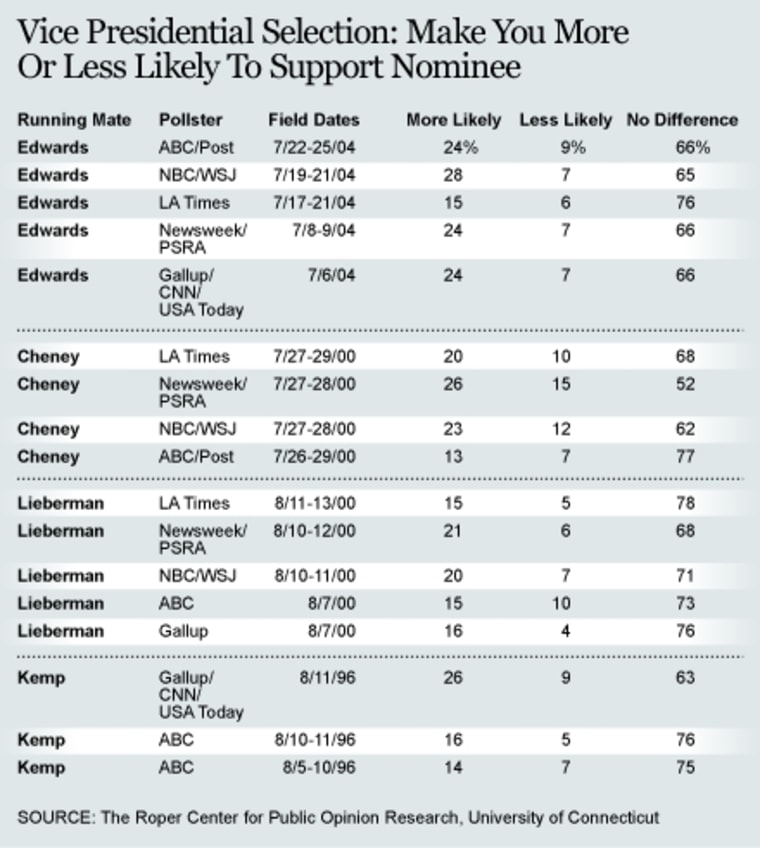Over the last week, my National Journal colleagues have kept asking one question: In looking at post polling, how will we judge the success or failure of the vice presidential choices by and ?
Unfortunately, the timing of the running mate announcements may well collide with the conventions themselves -- which, in a departure from prior elections, will occur in back-to-back weeks separated by the Labor Day weekend, when most Americans find a reason to be away from home. Put all that together and you have another source of pollster heartburn in a year already chock full of challenges.
Last week, the Gallup organization suggested one helpful yardstick. Since 1996, Gallup has conducted surveys in the time between the selection of the vice presidential candidates and the convention. In the four instances involving non-incumbents -- Bob Dole in 1996, George Bush and Al Gore in 2000 and John Kerry in 2004 -- Gallup shows "an average 5-point increase in the candidate's support."
In recent years, pollsters have also been asking voters a variant of this question: Does the vice presidential selection make you more likely to vote for the nominee, less likely, or won't it make any difference? The table below shows the results for the four most recent non-incumbent races.

As usual, different pollsters ask this question in slightly different ways, but despite the not perfectly comparable wording, the results have been reasonably consistent: A large majority of respondents each year say the VP selection makes "no difference" to their vote. Only about a quarter, at best, said they are "more likely" to support the nominee because of the running mate.
As such, we should not be surprised that, as Gallup reports, the small bounce in candidate support following the vice presidential selections "proves to be short-lived" as it is "quickly overtaken" by the conventions, debates and other campaign events.
Whatever the meaning of these momentary blips, the big practical challenge in assessing reactions to the running mates this year comes from the back-to-back scheduling of the two conventions with the three-day Labor Day weekend in between. If Obama does not announce his selection until later this week, then the first survey results will come from tracking polls conducted either in the midst of the conventions themselves or over the Labor Day weekend.
"Polling over Labor Day weekend is always a problem," CBS News survey director Kathy Frankovic reminds us. "We confront more than the usual number of people who don't respond or can't respond. People are away from their homes, heading back from summer vacation, or preparing their children for the start of the school year." And this coming weekend will not be much better.
So here's a suggestion: Withhold judgment until pollsters survey voters the week after the Republican convention. Then, to gauge the first impression made by the vice presidential nominees, compare their favorable ratings to those measured by past nominees after their respective conventions.
The table below shows favorable ratings measured by CBS News and the Gallup organization for vice presidential nominees over the last 20 years. I chose these two pollsters both because they have been using the same favorable rating measures for many years and because their measures are different. As explained in this space a few weeks back, the ratings used by CBS News (and the New York Times) offer respondents the option of saying they are "undecided" or "haven't heard enough" about the candidate to form an opinion. As such, Gallup's rating is a softer measure, giving us a sense of vague yet positive name recognition, while the CBS rating is a harder measure of more strongly held impressions.

By either measure, Al Gore narrowly wins as the selection with the strongest post-convention numbers. The 1992 convention served to bolster impressions of both Gore and Bill Clinton, and favorable impressions of both had increased by roughly 10 points compared to the survey conducted just after the announcement of Gore's selection. However, Gore ended the convention with a higher favorable rating as measured by CBS (39 percent) than Clinton (30 percent).
By and large, however, the contribution of the vice presidential nominees have typically been an echo of the top of the ticket. No wonder, then, that the VP bump tends to be fleeting.